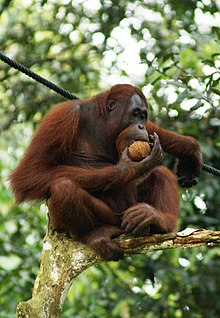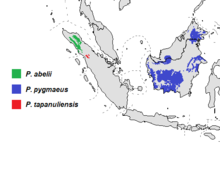Orangutan
Orangutans (Pongo) are great apes belonging to the rainforests of Indonesia and Malaysia. There are two species of orangutan. They are from Southeast Asia. There are very few of them left, because loss of the jungle has reduced their habitat. There are orangutans on view at the Singapore zoo.
| Orangutan Temporal range:
| |
|---|---|

| |
| Bornean orangutan (Pongo pygmaeus) | |
| Scientific classification | |
| Domain: | Eukaryota |
| Kingdom: | Animalia |
| Phylum: | Chordata |
| Class: | Mammalia |
| Order: | Primates |
| Suborder: | Haplorhini |
| Infraorder: | Simiiformes |
| Family: | Hominidae |
| Subfamily: | Ponginae |
| Genus: | Pongo Lacépède, 1799 |
| Type species | |
| Pongo pygmaeus | |
| Species | |
|
Pongo pygmaeus | |

| |
| Range of the three extant species | |
| Synonyms | |
|
Faunus Oken, 1816 | |

The name orangutan comes from two Malay words, orang which means person, and hutan which means forest; so orangutan means person of the forest.[1]
Taxonomy
change- Genus Pongo
- Bornean orangutan, Pongo pygmaeus
- Sumatran orangutan, Pongo abelii
- Tapanuli orangutan, Pongo tapanuliensis [2]
-
Sumatran Orangutan
-
Tapanuli Orangutan
Appearance
changeOrangutans have red-brown hair. They have long arms, and short legs. They can be strong like chimpanzees, gorillas and humans. They also have hands that are good for climbing. The Sumatran Orangutan is smaller and has longer hair than the Bornean orangutan. Orangutans have suffered from forest loss and are on the very edge of extinction.
Life
changeOrangutans are from the rainforests on the islands Borneo and Sumatra in Southeast Asia. They mostly live up in the trees. They eat fruit, leaves and bark and also insects and bird eggs. They drink water from rain that has been collected in leaves. Orangutans are not comfortable on the ground since they have to push themselves along with fists. Heavy adults move carefully through the trees, using their flexible feet to grasp the tree branches. Smaller orangutans swing with more ease.
Diet
changeAn orangutan's diet consists mainly of fruit, they like ripe fruit. If they cannot find fruit they will eat bark, leaves and termites, rather than move to somewhere else to get food. About 60% of an orangutan's diet is fruit, 25% is leaves, 10% is bark and flowers, and 5% is termites and other insects.[3]
Pregnancy
changeAfter a pregnancy of 230–260 days the female gives birth to usually one baby, but sometimes two, every eight to nine years. The little ones stay with their mother for years, riding on the mother backend and learning to move through the forest. The young orangutans are playful and affectionate. When they are five or six years old, they become more independent and eventually go off on their own.[4]
Related pages
changeReferences
change- ↑ "Orangutan Facts –". orangutans-sos.org. Sumatran Orangutan Society. 2011. Archived from the original on 23 August 2011. Retrieved 15 July 2011.
- ↑ The Tapanuli Orangutan was discovered in Sumatra in 2017.
- ↑ "What do Wild Orangutans Eat?". Archived from the original on 2015-11-07. Retrieved 2015-11-26.
- ↑ Blue Planet Level 5, written by Dinorah Pous p.70
Other websites
change- Primate Info Net Pongo Factsheet
- Information from Grungy Ape on the difference between the two Orang-utan species Archived 2010-01-05 at the Wayback Machine
- OrionSociety.org Archived 2007-02-08 at the Wayback Machine - 'Does an orangutan find Freedom in the Gift of Words? Do We?'
- Orang utan language project Archived 2009-03-18 at the Wayback Machine
- Facial Expression & Vocalizations
- Orangutan Foundation International non-profit organization dedicated to "support the conservation and understanding of the orangutan and its rain forest habitat while caring for ex-captive individuals as they make their way back to the forest."
- Orang Utan Republik Education Initiative non-profit organization whose mission is to secure the future of the orangutan through programs of education and outreach in Indonesia.
- The Borneo Orangutan Survival Foundation
- Sumatran Orangutan Society International non-profit organization dedicated to the protection of Sumatran orangutans